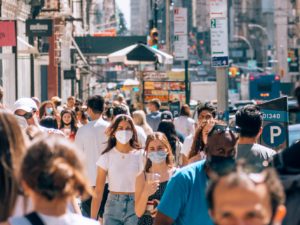8 Billion Reasons to Commemorate This Year's World Population Day
Written by Olivia Nater | Published: July 11, 2022
July 11th is World Population Day, which seeks to “focus attention on the urgency and importance of population issues.” World Population Day was conceived by the United Nations and first observed on July 11, 1990. According to the UN, our global population is expected to reach a major milestone this November: passing the 8 billion mark.
How we reached 8 billion
Due to historically high mortality, it took humanity until 1804 to reach a population of 1 billion. Since then, as a result of tremendous advances in medicine, death rates among all age groups—but especially among infants and young children—have plummeted and average life expectancy has drastically increased. The side effect of these welcome developments was that our population growth exploded. Our numbers have tripled since the 1950s, and we’ve added the most recent billion people in only 12 years. The latest UN population projections reveal that our population grew by around 0.8% last year, which means we added approximately 65 million people. This is substantially lower than the 80 million increase in previous years, partly due to the Covid-19 pandemic. The new UN data show that our annual population growth will likely increase again to around 70 million over the next few years and that we will hit 9.7 billion by mid-century and 10.4 billion by 2080. As our total population base is so big now, even a low growth rate still produces a large annual increase.
What a population of 8 billion means
Rapid population growth exacerbates many global challenges through unsustainable pressure on nature, services, and infrastructure.
Dwindling nature and natural resources
 Ever more people means ever less nature, as evidenced by some staggering facts. Over the last 50 years, our population has more than doubled while wild populations of mammals, birds, reptiles, and amphibians have plummeted by two-thirds on average. As our population grows, we use up more land and natural resources, pushing out wild species. The UN estimates that already one million species face extinction due to human activity, and this crisis is still accelerating.
Ever more people means ever less nature, as evidenced by some staggering facts. Over the last 50 years, our population has more than doubled while wild populations of mammals, birds, reptiles, and amphibians have plummeted by two-thirds on average. As our population grows, we use up more land and natural resources, pushing out wild species. The UN estimates that already one million species face extinction due to human activity, and this crisis is still accelerating.
Biodiversity loss and unsustainable resource use are not just bad for other species—they threaten our own survival too. Every human needs access to food, fresh water, shelter, and medicine, which all depend on a healthy natural environment. Fresh water shortages resulting from population growth, unsustainable agriculture practices, and climate change, for example, represent a rapidly growing threat to humanity.
More emissions, more climate impacts
Global greenhouse gas emissions are still rising due to humanity’s continued reliance on fossil fuels, combined with economic and population growth. We are already witnessing the disastrous, wide-reaching consequences, including more natural disasters, worsening inequalities, declining crop yields, and preventable deaths, which will all escalate as our planet continues to get hotter.
As we are running out of time to limit catastrophic climate change, governments must ramp up actions that are maximally effective in the short-term, such as a global transition to renewable energy sources and transforming our food systems. In the long-term, slowing population growth can make a big difference—research from Project Drawdown suggests that achieving a smaller future population is one of the most powerful available climate solutions.
Higher pandemic risk
 Covid-19 demonstrated how incredibly vulnerable our global population is to novel diseases. All recent pandemics and epidemics, from Covid to SARS to Ebola, are a result of humanity’s relentless exploitation of nature. They are zoonotic diseases, meaning they originated in wild animals and jumped to humans because of our encroachment into nature (largely through deforestation and agriculture), the wildlife trade, and hunting. A large and growing human population means our destructive activities will be amplified, and high population density makes it easy for new viruses to spread.
Covid-19 demonstrated how incredibly vulnerable our global population is to novel diseases. All recent pandemics and epidemics, from Covid to SARS to Ebola, are a result of humanity’s relentless exploitation of nature. They are zoonotic diseases, meaning they originated in wild animals and jumped to humans because of our encroachment into nature (largely through deforestation and agriculture), the wildlife trade, and hunting. A large and growing human population means our destructive activities will be amplified, and high population density makes it easy for new viruses to spread.
Scientists have warned that if we don’t change our ways, the next pandemic is just around the corner. In the first year of the Covid pandemic, the Intergovernmental Science-Policy Platform on Biodiversity and Ecosystem Services (IPBES) stated:
“Without preventative strategies, pandemics will emerge more often, spread more rapidly, kill more people, and affect the global economy with more devastating impact than ever before.”
Their report points out the urgent need to tackle the root causes of pandemics, which “are the same global environmental changes that drive biodiversity loss and climate change.” By stabilizing our population as soon as possible and ending unsustainable resource consumption, especially in rich countries like the U.S., we can ease our pressure on the environment and protect our health.
Vulnerable communities are hardest-hit
The areas with the most rapid population growth are also the ones that are disproportionately impacted by environmental and humanitarian crises. The population of sub-Saharan Africa, which contains some of the world’s poorest countries, is projected to double between 2020 and 2050 due to persistent barriers to family planning and demographic momentum (a large number of people of childbearing age). The African continent currently has just over 18% of the current global population, but by 2100, with a global population of 10.4 billion, 38% will be in Africa.
According to the UN Department of Economic and Social Affairs:
“Sustained, rapid population growth adds to the challenge of achieving social and economic development and magnifies the scale of the investments and effort required to ensure that no one is left behind. Rapid population growth makes it more difficult for low-income and lower-middle-income countries to afford the increase in public expenditures on a per capita basis that is needed to eradicate poverty, end hunger and malnutrition, and ensure universal access to health care, education and other essential services.”
In other words, attempting to improve people’s well-being in less developed countries is increasingly like running to stand still. An estimated 218 million women in low- and middle-income countries have an unmet need for family planning, up from 194 million in 2000 due to rapid population growth outstripping progress. Too many people are still plagued by hunger and malnutrition, insufficient health care, poor education systems, and internal conflict, among other issues. Without a dramatic increase in overseas aid, these conditions are likely to worsen under rapid population growth.
We can build a brighter future
The good news is that investing in the most powerful development levers, including girls’ education and comprehensive family planning programs, and advancing women’s rights, also happens to be the most effective way to slow population growth. The UN’s Sustainable Development Goals (SDGs), which aim to achieve a good quality of life for all on a healthy planet, are currently far out of reach, but they don’t have to be a distant dream.
While we’re certainly going to zoom past the 8 billion mark, a population of more than 10 billion by the end of the century is not a given, and under the UN’s most optimistic scenario, our population in 2100 could be lower than today’s. To make this possible, world leaders must do more at both national and international levels, including closing the substantial family planning funding gap—the difference between what is needed to end unmet need for family planning and what has been pledged by national governments and donor countries and agencies.
By raising awareness of population challenges, as World Population Day aims to do, we can put pressure on policymakers to facilitate change and inspire more individuals to take action for a better future.

